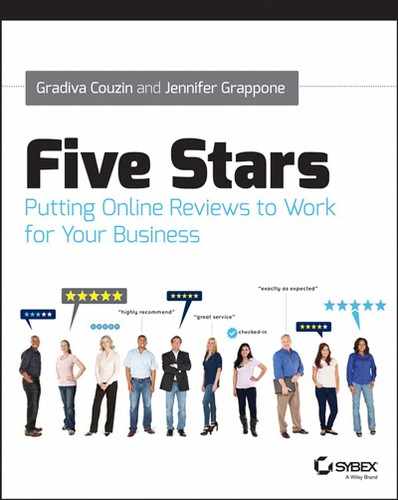Chapter 2
The Online Reviews Landscape
If you scratch the surface beyond the familiar Yelp reviews and Amazon stars, the online review landscape is large and complex. Whether you’re a local business owner, a brand manager, a marketer, or a service professional, chances are you didn’t study this stuff in school. We won’t blame you if you feel lost! Read on to find your way.
In this chapter:
- Types of online reviews
- Types of review sites, platforms, and services
- Fake reviews
In this chapter, you’ll get your basic training on the various types of online reviews, where and how they are posted, and in what venues they are seen.
As we walk you through this landscape, we’ll point out the ugly side too: fake online reviews. We’ll explain why they exist, how many of them there are, and what the review sites and services are doing to fight them.
Types of Online Reviews
The expression online review can mean different things to different people. We define it as any online expression of a customer’s, client’s, patient’s, or patron’s opinion. Yup, that means everything that just about anyone you interact with says about you online counts.
To get a handle on a complicated system, it helps to parse it out into manageable pieces. Here are some basic types of online reviews:
Figure 2-1: Product review on REI.com

Figure 2-2: Company review (also called seller rating or merchant review) of USB Memory Direct

Figure 2-3: Brand comment on Twitter, including photo
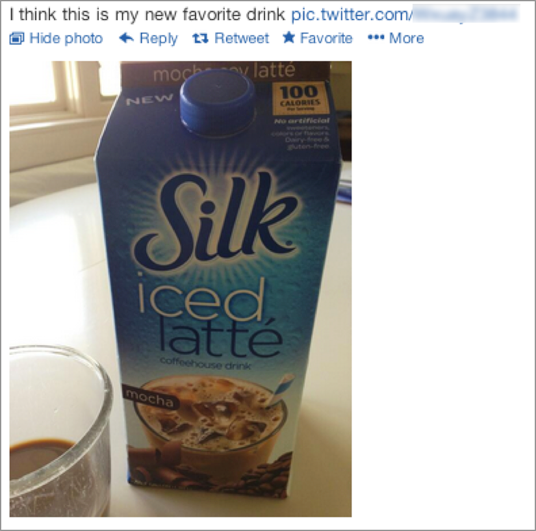
Figure 2-4: Solicitation for customer answer
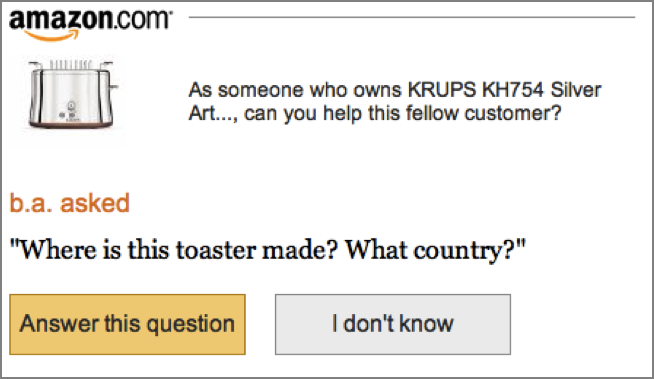
Figure 2-5: Customer satisfaction survey

Figure 2-6: Customer complaint on ripoffreport.com
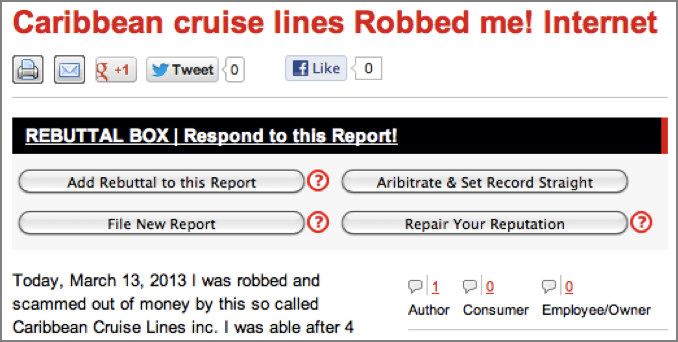
Now that you know the various types of online reviews, we’ll walk you through the many paths that an opinion can take on its way from one customer’s thought bubble to another’s computer screen.

Types of Review Sites, Platforms, and Services
Different types of reviews are often collected and displayed via entirely different processes or services, so it’s time to familiarize yourself with the types of review sites and platforms that you might need to work with for your business’s online reviews management efforts.
This is a dynamic, evolving, and sometimes overlapping industry. The following businesses have their own ways of describing themselves, but we’ve grouped the various review sites and platforms into categories that we think will be most helpful to you as a business stakeholder.
Review Sites
Imagine a large party, with lots of folks milling about. The hosts have one important rule: Gossip all you want, but tell the truth. Throughout the evening, partygoers are dishing the dirt: “Did you hear about the cupcakes at CakeNation? They’re exquisite.” “They’re delicious, but stay away from the carrot cake cupcakes—too many raisins!” “Are you kidding? The donut place across the street is just as good—and half the price.” This is the kind of party being thrown by Yelp, TripAdvisor, and other review sites that primarily exist to showcase consumer-generated reviews. Table 2-1 shows a selection of popular review sites.
Table 2-1: Review sites
| Examples of review sites | Yelp TripAdvisor Citysearch Urbanspoon Insider Pages Angie’s List |
| Who is reviewed? | Any business with a physical presence, including service providers, such as roofers, who travel to their customers’ locations. |
| Where they stand on businesses encouraging reviews | Generally opposed to businesses offering incentives for reviews. Most are okay with asking, but Yelp is a notable exception. |
| Where reviews are seen | Reviews are displayed on the review site and affiliated mobile apps. Reviews often feature prominently in search results. |
| How they work with businesses | Review sites will list a business regardless of the business’s intervention. Businesses can often claim and improve their listing and may be able to respond to reviews. Promoted placement and advertising is often available. |
To succeed, these sites rely on gathering and displaying as many reviews as possible, and developing the perception that these reviews are trustworthy, to foster the virtuous cycle of more site visitors and more reviewers.
Since trustworthiness is key, these sites work hard to moderate and filter reviews that seem iffy. Back to our party metaphor, if a celebrant has a bit too much champagne and says something out of line like “CakeNation? That place only lets you in if you’re one of those Green Party nutjobs,” the hosts of the party will come along and hush that type of talk. In other situations, someone may drop a fib into the conversation. For example, if a guest is dripping with diamonds, you may not believe her when she says, “Oh, CakeNation! I go there because it’s such a bargain, and I am always pinching my pennies.” Our party hosts will shoo our spurious socialite out of the room to keep the integrity of the party intact. Just like our party hosts, review sites try to filter out reviews that appear fake or fraudulent or are generated in an unnatural way.
How They Work
For companies like Yelp and TripAdvisor, visitor engagement is the primary asset, and reviews keep the visitors engaged. These sites need a certain volume of reviews to stay healthy, which is why the following factors are typically true about review sites:
- Individual reviews are accessible via the search engines, providing a path for visitors to enter the site.
- Business owners can’t opt out. Any user can add a business, and although business owners have the power to claim their profile, they do not have the power to delete it.
- The sites sell advertising and enhanced listings to businesses.
- The site rewards heavy reviewer participation with badges, labels, or real-life perks.
Studies show that, in order to trust reviews, people need to see volume and diversity of opinion. This is one reason review sites work so hard to filter out fake reviews, and businesses often find their legitimate positive reviews caught in that net. Site visitors will trust the review site less if they feel business owners can manipulate reviews.
Although credible review sites do care what business owners think, customers—not businesses—have to trust these sites, and use them in bulk, in order for the review sites to thrive and make money. It is the volume of reviews that drives the ability to charge for advertising, because where customers go, the advertisers (the businesses who are trying to attract these customers) will follow.
Visibility for the Reviews
Review sites typically have a lot of visibility in search engine results. These sites work hard at search engine optimization (SEO) techniques to make sure that individual reviews display in the search results, decorated with those lovely yellow stars (Google calls these rich snippets). Review site pages commonly get top Google spots for brand-agnostic searches such as <pet grooming> or <miami pet grooming> as well as branded searches such as <st judes mobile pet grooming>. Figure 2-7 shows one such Google listing with rich snippet review stars.
Figure 2-7: A listing for a review site in Google’s search results. The stars and the breadcrumb navigation links are examples of rich snippets.

To foster increased usage, review sites have also dedicated resources to perfecting their own mobile apps and search capabilities. This encourages users to go straight to the source, bypassing the search engines, who are, after all, displaying competing reviews. Yelp, OpenTable, Urbanspoon, and TripAdvisor offer intuitive, convenient mobile experiences, and Foursquare and Facebook check-ins are inherently mobile. Apps such as Raved are at the busy intersection of local and social, aggregating Facebook likes and check-ins and Foursquare check-ins from friends.
Businesses of the brick-and-mortar persuasion have a seemingly endless array of review sites to think about. To help you get your bearings, we’ve compiled a partial list of review sites in Table 2-2.
Table 2-2: Online review sites applicable to local businesses
| Site name | URL | In a nutshell | ||
| All kinds of local businesses and service providers | ||||
| Yelp | www.yelp.com | Popular review site includes a wide range of local businesses, from pizza joints to podiatrists. | ||
| Google+ Local | plus.google.com/local, maps.google.com, and integrated into results on google.com | Google’s own environment for reviews of local businesses is integrated with Google Maps and Google+. Includes Zagat reviews, reviews posted on Google by users, and links to reviews posted elsewhere. | ||
| Yahoo! Local | local.yahoo.com | Integrated with Yahoo! maps and local business listings. Hosts its own reviews and also aggregates reviews from elsewhere on the Web. | ||
| Citysearch | citysearch.com | Longstanding local business site features elite “scouts” offering reviews in addition to submissions from the public. | ||
| Foursquare | foursquare.com | Location-aware check-in site allows customers to post 200-character tips for businesses with a physical location. | ||
| YP.com | www.yellowpages.com | Old-school Yellow Pages listings are sparsely sprinkled with customer reviews. | ||
| Superpages | www.superpages.com | Yellow pages–style directory has space for local business reviews. | ||
| Judy’s Book | www.judysbook.com | User reviews of businesses in wide-ranging categories from dining to school to health care. | ||
| MerchantCircle | www.merchantcircle.com | Merchant directory with user reviews. | ||
| FindTheBest | www.findthebest.com | Data-driven comparisons of pretty much anything you can think of, businesses and products included. Some user reviews. | ||
| Restaurants | ||||
| Urbanspoon | www.urbanspoon.com | Popular restaurant review site aggregates critic, blogger, and diner reviews. | ||
| OpenTable | www.opentable.com | Primarily a restaurant reservation platform, but displays and collects reviews from diners. | ||
| Seamless | www.seamless.com | Online ordering for delivery or pickup. Customers can rate and review restaurants. | ||
| MenuPages | www.menupages.com | Menus, reservation info, and reviews for restaurants in a select list of cities. | ||
| GrubHub | www.grubhub.com | Site for ordering delivery from nearby restaurants includes restaurant reviews posted by its users. Also aggregates Yelp reviews. | ||
| Eat24 | eat24.com | Includes restaurant reviews in addition to delivery order service. | ||
| Restaurantica | www.restaurantica.com | Local restaurant and nightlife guide with user reviews. | ||
| Hotels, travel, and attractions | ||||
| TripAdvisor | www.tripadvisor.com | Popular review site is focused on hotels but also includes reviews of destinations, attractions, and restaurants. | ||
| Hotels.com | www.hotels.com | Major hotel review site includes user reviews and TripAdvisor ratings. | ||
| Travelocity | www.travelocity.com | Major online travel agent (OTA) allows travelers to post reviews of hotels, cruises, and activities on a scale of one to five smiley faces. | ||
| Orbitz | www.orbitz.com | Major OTA allows travelers to post thumbs up/down reviews of hotels and cruises. | ||
| Expedia | www.expedia.com | Major OTA allows verified guests to post reviews of hotels and cruises. | ||
| Booking.com | www.booking.com | Hotel booking site allows travelers to post reviews. | ||
| Skytrax | airlinequality.com | Airline and airport reviews from travelers. | ||
| Health | ||||
| Healthgrades | www.healthgrades.com | User reviews for doctors, dentists, and hospitals. | ||
| Vitals | www.vitals.com | Physician reviews from patients. | ||
| Wellness | www.wellness.com | Site for finding health, wellness, and lifestyle information. Contains some provider reviews. | ||
| RateMDs.com | www.ratemds.com | User reviews for doctors, dentists, and hospitals. | ||
| Home services | ||||
| Angie’s List | www.angieslist.com | Popular site charges a fee to access reviews. Focuses on home services but also includes health, automotive, and other categories. | ||
| Kudzu | www.kudzu.com | Reviews compiled from around the Web for local home and health services. | ||
| Insider Pages | www.insiderpages.com | Citysearch partner includes all types of local businesses but with an emphasis on health and home services. | ||
| Automotive | ||||
| DealerRater | www.dealerrater.com | Automotive dealership reviews. | ||
| Edmunds.com | www.edmunds.com | Popular site for new and used car information. Includes dealership reviews. | ||
| Cars.com | www.cars.com | Major site for automotive information allows users to post reviews of dealers. | ||
| Legal | ||||
| Avvo | www.avvo.com | Lawyer reviews posted by both clients and peers. | ||
| Lawyers.com | www.lawyers.com | A resource for legal information; uses both client and peer reviews to rate lawyers. | ||
| Super Lawyers | www.superlawyers.com | Rates outstanding lawyers based on peer recognition and professional achievement. No user reviews. | ||
| Schools and nonprofits | ||||
| Charity Navigator | charitynavigator.org | Nonprofit charity evaluations based on financial and other data. | ||
| GreatSchools | www.greatschools.org | User reviews for educational facilities from preschool through college. | ||
| ChurchRater | churchrater.com | User reviews and ratings for local churches. | ||
Social Commerce/Product Review Platforms
Almost any website that sells products can integrate product reviews into its shopping experience. This can be done by setting up the review collection and display features that come with your e-commerce platform (or its compatible add-ons), or by integrating a social commerce platform such as Bazaarvoice or Reevoo. Social commerce platforms may be the biggest review venue that you haven’t heard of. From the consumer’s point of view, the platforms are often invisible, because the reviews that they host are seamlessly integrated into the design of product pages on e-commerce sites.
Product reviews collected on your site will not make their way onto review sites like Yelp and TripAdvisor. But they reach far and wide, and Bazaarvoice in particular is a behemoth. In a 2013 keynote speech, Bazaarvoice’s CEO and President Stephen Collins claimed that Bazaarvoice connects monthly with 400 million unique shoppers worldwide and described Bazaarvoice as the world’s largest consumer network. Table 2-3 shows platforms that handle product reviews.
Table 2-3: Social commerce and product review platforms
| Examples of social commerce and product review platforms | Bazaarvoice Reevoo Feefo Pluck eKomi PowerReviews (acquired by Bazaarvoice) Google Shopping Review functionality features of e-commerce platforms such as Shopify or Volusion |
| Who is reviewed? | Primarily products. |
| Where they stand on businesses encouraging reviews | Asking customers for reviews is a key service offering of many social commerce platforms. |
| Where reviews are seen | Product reviews, Q&A, and other user-generated content are displayed on product pages on retailers’ or manufacturers’ websites where products are sold. Product reviews from various sources are displayed in the Google Shopping interface. |
| How they work with businesses | Social commerce and product review platforms are integrated with e-commerce websites and connect with your customers to encourage new reviews, as well as discussion and interaction around your products. They can require extensive implementation with varying features and fees. |
How They Work
When a store or manufacturer hires a social commerce company or implements review functionality from their e-commerce platform, software is integrated on their website to perform some or all of the following functions:
- Send post-purchase emails to customers
- Collect verification information from reviewers and purchasers
- Moderate reviews
- Populate the reviews onto the seller’s or manufacturer’s website
- Provide insights, alerts, and communication pathways that allow businesses to better understand and engage with their customers
- Control the display of reviews and other user-generated content
Features vary widely among product review platforms. Some include only basic review capabilities, while others—sometimes giving themselves the “social commerce” moniker—offer a more sophisticated social platform, providing a technical backbone for brands or retailers to strategically place opportunities in front of customers to read and write reviews, ask a question, or otherwise connect around a product.
Even if your business is small, don’t assume you can’t afford to have product reviews on your site. Platforms known for high-end enterprise integration often offer solutions with prices that are within reach for small business.
Gathering Reviews
Many of these platforms gather product reviews by sending post-purchase emails to customers. In some cases, site visitors can initiate the reviewing process by navigating to product pages on e-commerce sites that have integrated product review platforms and then clicking a “write a review” link. Some benefits of this type of review-gathering process include:
Visibility for the Reviews
One big advantage of using social commerce and product review platforms is that the reviews they collect are integrated into the seller’s or manufacturer’s website (see Figure 2-8). Study after study has shown the benefits of customer reviews on e-commerce sites: Reevoo reports that reviews result in an 18% average uplift in sales, and an iPerceptions study found that 63% of customers are more likely to make a purchase from a site with user reviews. Marketers call this effect social proof, which is a fancy way of saying that people do what they see other people doing.
Figure 2-8: Reviews from Reevoo integrated into a product page on sony.co.uk
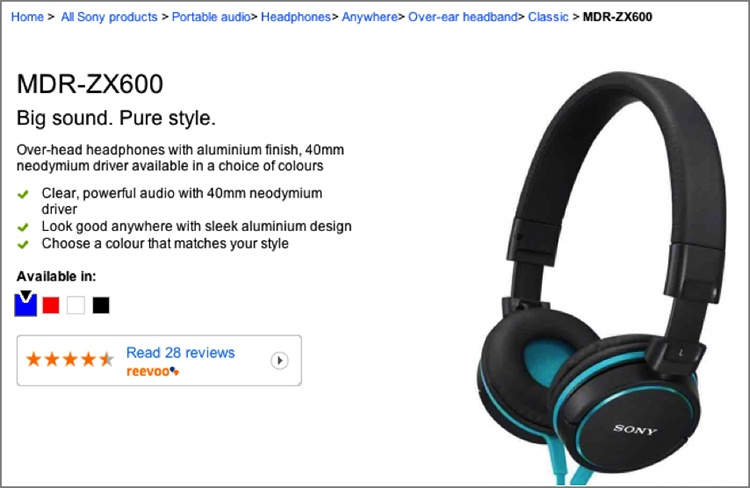
Many social commerce platforms claim that the reviews they generate are great for SEO, improving ranks and search engine traffic to product pages. The logic behind this claim is that the search engines tend to favor pages with fresh content, so the constant influx of new review text will be a boon for a product page’s ranks. We don’t disagree with this in principle, but we don’t think you’ll achieve your SEO goals with online reviews alone.
Social commerce platforms tend to make strong claims about SEO benefits, and we encourage you to take this talk with a grain of salt.
E-Commerce Merchant Review Collection Services
For companies hoping to jump-start the collection, display, and management of online merchant reviews, e-commerce review collection services offer some reasonably affordable and practical options. Table 2-4 shows a partial list of companies offering e-commerce review collection.
Table 2-4: E-commerce merchant review collection services
| Examples of e-commerce merchant review collection platforms | ResellerRatings Shopper Approved Trustpilot RateItAll eKomi Google Wallet BizRate Insights Reviews.co.uk |
| Who is reviewed? | Primarily e-commerce retailers, although some services review travel and local businesses. True to its name, RateItAll allows reviews of anything from jelly beans to Julius Caesar. |
| Where they stand on businesses encouraging reviews | Most offer customer outreach/review solicitation as a service. |
| Where reviews are seen | Reviews reside off your site on review destination pages managed by the service. Reviews can also show up in Google Shopping pages and in Google AdWords seller rating extensions. |
| How they work with businesses | Some allow businesses to get reviewed without taking any steps, whereas others require a paid account. Businesses must pay for customer outreach and other features. Google Wallet’s review collection tools are a small component of its integrated e-commerce system. |
How They Work
E-commerce merchant review collection services offer a variety of options, but in general, they provide tools to help businesses collect reviews from customers, widgets or badges to link to these reviews, and opportunities for responding to reviewers. Monthly fees can be low—or even free—but scale up based on review volume and other factors. These services may be particularly appealing to companies that advertise in Google Shopping and Google AdWords, where reviews may receive a lovely visibility boost (see “Visibility for Reviews,” later in the chapter).
All of these services can help you collect reviews via your website or purchase process, whereas some, such as ResellerRatings, supplement this proactivity with passive review collection that takes place on their own publicly accessible review site. Google Wallet is a horse of a different color, offering not only review collection services but also sophisticated online and mobile in-store payment solutions for merchants.
Some reputation management services (described later in this chapter) also act as third-party collection services. In contrast to many reputation management services, e-commerce review collection services do not allow a business to moderate reviews or control which customers are approached for reviews, although they may offer a buffer period before reviews are published, during which businesses may be able to contact the reviewer.
Gathering Reviews
In a typical paid implementation, these services integrate with your purchase confirmation process to help you collect reviews of your company from customers who have engaged in recent transactions. These services can be quick and easy to implement. For example, some simply require you to paste a special email address into the BCC field of your customer emails, and they do the rest, reaching out to customers post-purchase and encouraging reviews. The “real person” factor varies greatly from service to service, with some allowing reviews from anyone who stumbles across the “post a review” link, and others requiring purchase verification. Most provide some ability for businesses to respond to reviews, either by posting online or by emailing the reviewer directly.

- Popped into the customer’s own Facebook status. These are likely to be invisible to you, but plenty visible to the commenter’s friends.
- Dropped onto your business’s Facebook page. These are easy for you to find, and just as easy for prospective customers to see.
- Uploaded onto YouTube as a video that might be one keyword search away from the eyes of a stranger.
- Tucked into a check-in on Foursquare, where anyone who wanders by can enjoy reading tips about your business.
- Tossed onto Twitter in the form of a tweet that mentions your Twitter handle or your company or product names. Tweets can be seen publicly, although direct messages (DMs) cannot.
- Cross-posted from one medium to another. This is the case with the pictured tweet, in which a tip originated in Foursquare but was published on Twitter.
Be warned: Reviews gathered by these services or using their tools are not necessarily the property of your business. Once you cancel your subscription, reviews may even be removed. You may not be able to respond to your business’s reviews unless you are an active subscriber to the service. Before you sign up with a service, it’s worth your while to investigate what will happen once you cancel your monthly fee.
Visibility for Reviews
There are several ways that reviews gathered by e-commerce collection services can be seen online:
Figure 2-9: The Shopper Approved badge adds a trust signal to an e-commerce site.

Figure 2-10: Google Shopping seller ratings for eBags are aggregated from numerous sites and review collection services.
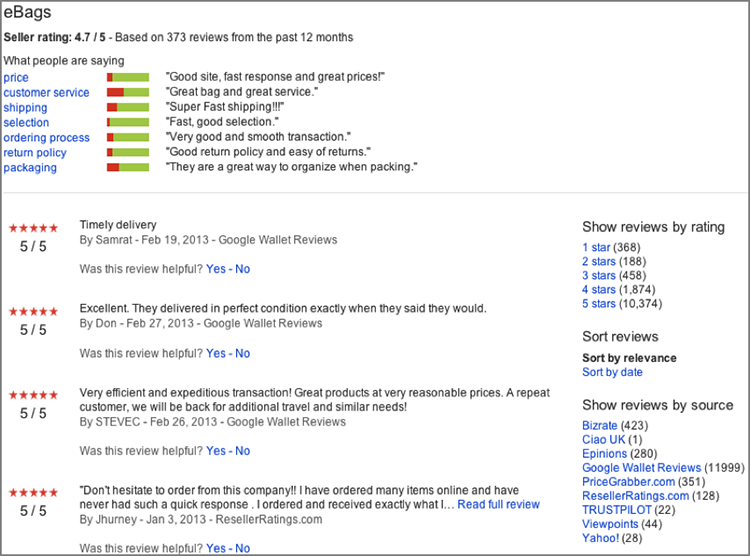
Shopping Comparison Sites and Online Travel Agents
Comparison sites like Shopping.com, Epinions, and NexTag, and OTAs like Orbitz, Expedia, and Booking.com, offer customers a convenient way to compare products for sale from different providers side by side. One way these sites add value is by displaying customer reviews so site visitors can feel great about making an informed purchasing decision. Table 2-5 provides a partial list of shopping sites and OTAs.
Table 2-5: Shopping comparison sites and OTAs
| Examples of shopping comparison sites and online travel agents | Bizrate Shopping.com NexTag Google Shopping Orbitz Travelocity Expedia Hotels.com |
| Who is reviewed? | E-commerce retailers, products, hotels, cruises. |
| Where they stand on businesses encouraging reviews | All for it! These services generally seek reviews after the transaction. |
| Where reviews are seen | Reviews are primarily seen in the shopping site or OTA interfaces. |
| How they work with businesses | Businesses that pay to sell products or services via these sites have the opportunity to be reviewed there; Bizrate also offers a free option. |
How They Work
To be listed in a shopping comparison site or OTA, providers must have a relationship with the site. For shopping comparison sites, the relationship is simple to set up: A retailer signs on the dotted line and submits a product feed to the shopping site. When a customer clicks from the comparison site to the retailer, the retailer pays a fee, usually calculated on a pay-per-click basis. In most cases a retailer must sell products via the comparison shopping site in order to be included there.
OTAs run on a similar model in which providers such as hotels, cruise lines, and tour operators pay a commission to the OTA on any transaction that the OTA completes on their behalf (through some sort of negotiation wizardry, airlines and car rental agencies get a free ride and don’t pay these commissions). One big difference between OTAs and comparison shopping sites is that OTAs complete the transaction themselves, rather than passing the customer over to the service provider. In other words, if the Griswold family books a hotel through Orbitz, then they pay Orbitz, and Orbitz pays the hotel. If the Griswolds have a complaint or accolade to share, they may be confused about whether to communicate it to Orbitz or the hotel manager.
Shopping comparison and OTA sites make money by maximizing the volume of traffic and sales that visitors initiate from their sites, and research shows that a person is more likely to convert from a “looky-loo” to a purchaser after reading reviews. It doesn’t take a rocket scientist to connect the dots: More reviews mean more revenue for the shopping comparison or OTA site. And they know it: According to research by PhoCusWright, OTAs have become aggressive about pursuing additional customer reviews on their sites, and as a result, more than two-thirds of all hotel reviews were posted on OTAs in 2010. Expedia alone reported that it had over 7.5 million guest reviews in 2012, with 500,000 new ones added per year.
Gathering Reviews
Merchants who sign up to list products on a comparison shopping site usually have the opportunity to set up a customer feedback component. This system reaches out to buyers immediately after the sale, and again after the expected delivery date, to request that the customer post a review.
Google Shopping is a special case: It is essentially a comparison shopping site integrated into Google search results. Merchants create product listings by providing a feed via Google AdWords, and pay on a per-click basis each time a visitor clicks on a product listing. However, unlike other comparison shopping sites, Google Shopping does not reach out to request reviews from buyers after the purchase is complete. Instead, Google Shopping displays product reviews that merchants have gathered on their own sites. Because the same product can be sold by several different vendors, Google Shopping sometimes aggregates product reviews from more than one seller. In Figure 2-11, Google Shopping shows reviews for a digital camera available from both Best Buy and Adorama.
Figure 2-11: Product reviews displayed in Google Shopping results
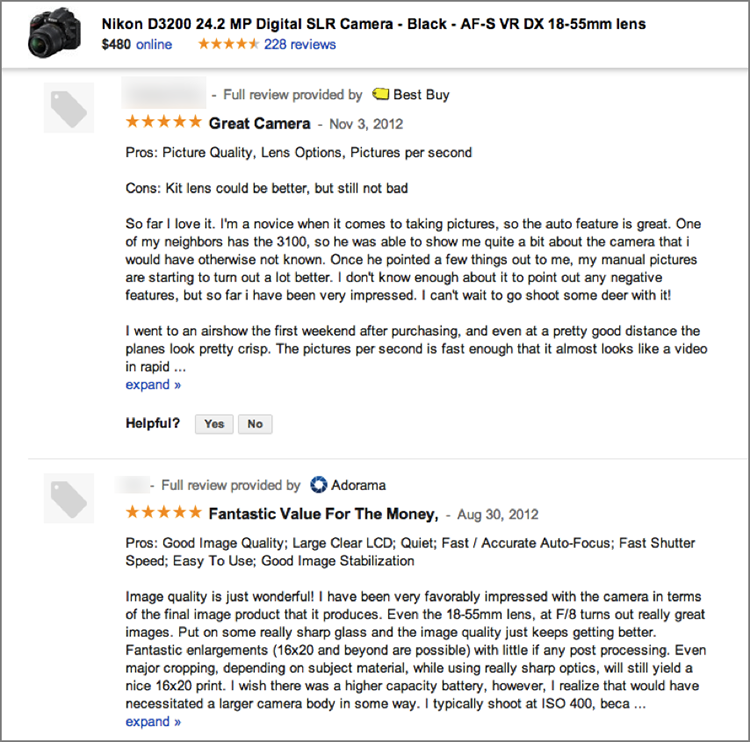
OTAs follow yet another procedure for building their portfolio of customer reviews. Because OTAs complete transactions in a direct relationship with customers, they have easy access for gathering reviews. OTAs will typically follow up a customer’s hotel stay with a feedback survey sent via email. OTA reviews come from verified purchasers, so they get bonus points in the credibility department.
Visibility for Reviews
Customer product reviews are integrated with the shopping experience on shopping comparison sites, looking and behaving like product reviews that you’ve seen on individual retailer sites. An example of a product page on Shopping.com featuring reviews is shown in Figure 2-12.
Figure 2-12: Product reviews on Shopping.com
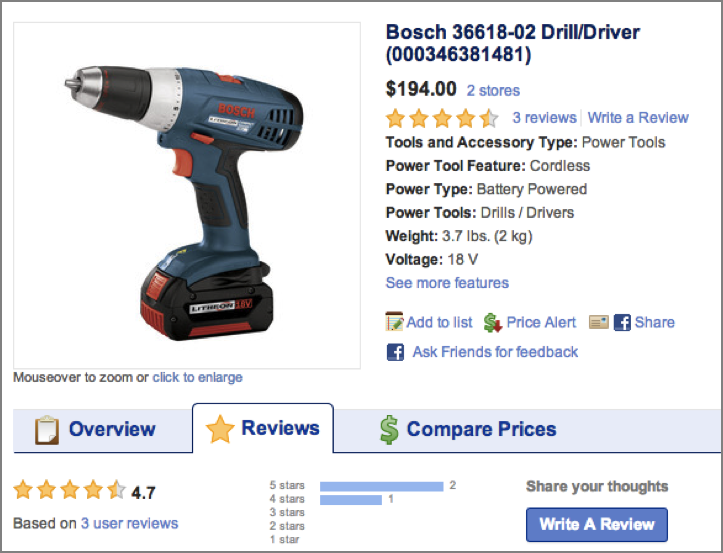
In addition to product reviews, customers can leave seller reviews to describe their experience with a retailer’s customer service. With this info, a customer might decide that a rock-bottom price isn’t worth the risk of buying from a 1-star seller. Seller ratings can be seen on PriceGrabber.com in Figure 2-13.
Figure 2-13: Seller ratings on PriceGrabber.com
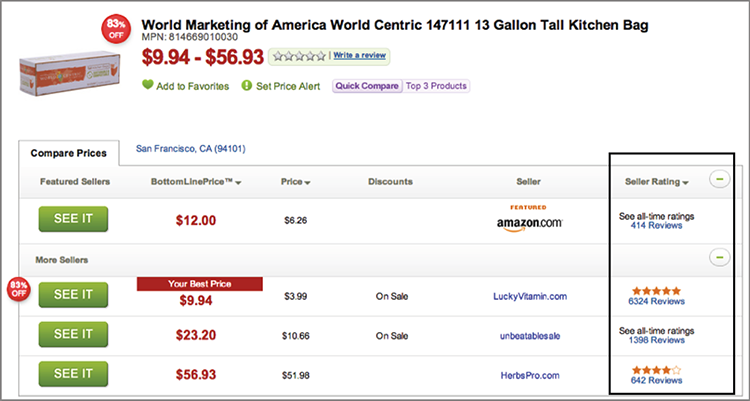
Online travel agencies show reviews on hotel profile pages and throughout the site, as seen in Figure 2-14.
Figure 2-14: Hotel reviews on Expedia
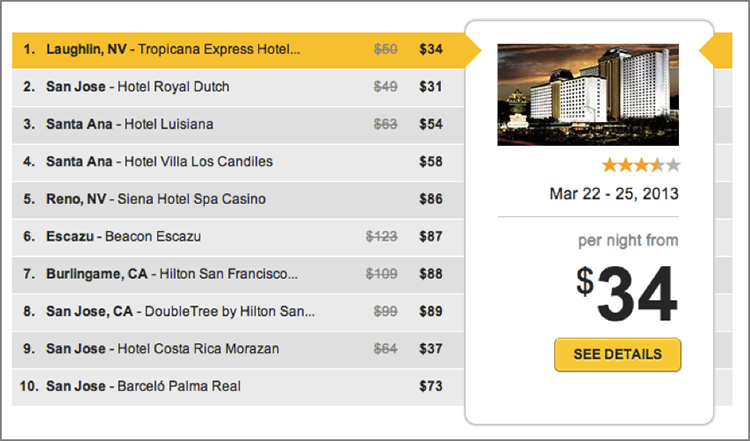
Seller ratings posted on shopping comparison sites can find their way into Google Shopping, as you saw in Figure 2-10, and Google also throws these reviews into its calculation for star ratings in AdWords ads. Shopping comparison sites also feature prominently in Bing paid search results, as shown in Figure 2-15.
Figure 2-15: Eye-catching shopping comparison site reviews in Bing’s paid search results
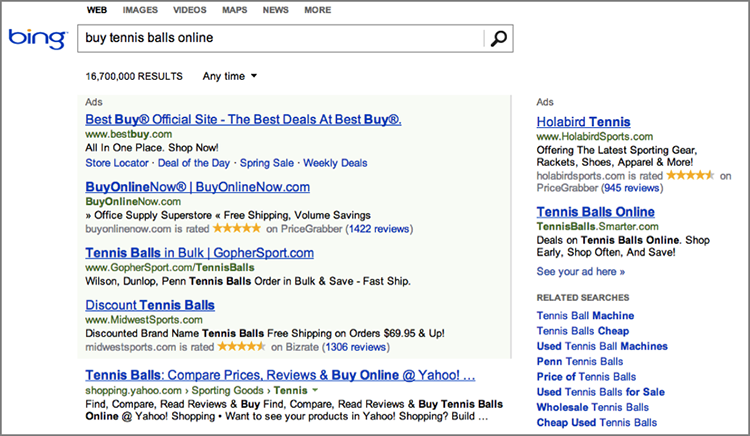
Reputation Management Services
You’re probably reading this book because you’re feeling some level of concern about your online reputation; perhaps for that very same reason, your curiosity has been tickled by ads from reputation management companies such as Reputation.com, Customer Lobby, and Demandforce. Among other things, these firms give customers the opportunity to bulk up on customer reviews and gain some control over the gathering and display of their reviews. Table 2-6 shows features of reputation management services.
Table 2-6: Reputation management services
| Examples of companies offering reputation management services | Reputation.com Customer Lobby Demandforce Presto Reviews Genbook |
| Who is reviewed? | Primarily brick-and-mortar businesses, but a growing number of services exist for e-commerce sites and brands as well. |
| Where they stand on businesses encouraging reviews | All for it! Encouraging reviews is at the heart of their offerings. |
| Where reviews are seen | Posted on the business’s own website and on the reputation management service’s site. Reviews can show up in search results and may be syndicated to other review sites as well. |
| How they work with businesses | Businesses hire these services to help them monitor and generate reviews. Reputation management may also be part of a broader service, such as appointment management. |
How They Work
With offerings ranging from automated tools to consulting services, these companies are difficult to lump together into a single category. Similar to the e-commerce review collection services described earlier in this chapter, these firms often function as third-party review collection services. However, reputation management comes into play with additional services such as syndicating reviews to review aggregator sites, strategically encouraging customers to post reviews in certain venues, and, in some cases, providing business owners with control over the review content that is published.
The relationship between a business and a reputation management company begins when the business signs up for a service package. The charge is likely to be a flat monthly fee for access to a suite of tools, which can start under $100 but can get quite pricey when optional add-ons such as consulting services are purchased.
Gathering Reviews
Businesses that sign up with this type of service will usually get a profile page on the service’s website. This page displays reviews that can be collected in a number of ways, including email solicitations, in-house collection (for example, on a smartphone or a kiosk), or via a survey by phone or mail. Figure 2-16 shows a profile page for a mechanic on the Customer Lobby website.
Figure 2-16: Customer Lobby business profile page
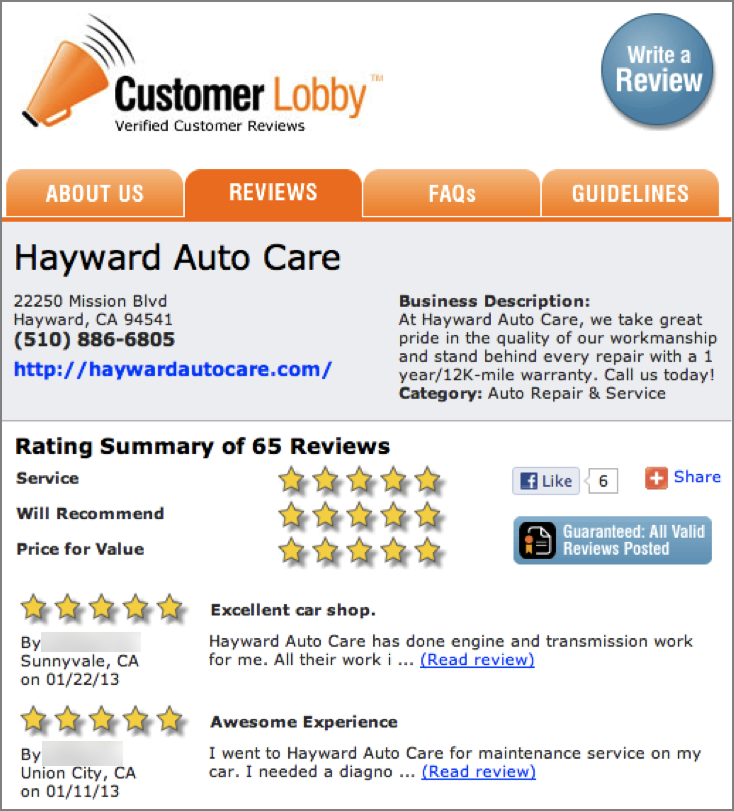
Typically, a business has no control over which reviews get published and which don’t. But some services offer measures of control that are a bit more business-centric than you’ll find elsewhere in the reviewscape. For example, a business may be able to challenge a review it doesn’t think is real, clear up a problem and request withdrawal of a negative review, or even specify which customers it wants the reputation management service to approach when seeking reviews.
Although most of these services do not offer outright rejection of reviews, some do, and this, along with some of the more outrageous promises made by a few unscrupulous firms, is one reason that reputation management services tend to have reputation management issues of their own.
Details of the review-gathering process vary among the various reputation management firms. Reputation.com offers a smartphone-based system for on-location review gathering. At Genbook and Demandforce, review gathering is integrated into an appointment management system—a good choice for service providers such as dentists and hair salons. Presto Reviews even offers a freestanding reviews kiosk, as seen in Figure 2-17.
Figure 2-17: Presto Reviews kiosk

Some reputation management firms take review gathering a step further by posting reviews on behalf of customers. For example, a company may send out survey cards to customers and then “digitize” them by posting onto Google+ Local or other review sites. Google explicitly warns against this practice. We believe the reputation management services we’ve named in this chapter don’t do this, but be sure to double-check when you’re hiring.
Despite the variations between services, the basic foundation remains the same for them all: Your business gains a system for requesting reviews from customers and also gains some degree of control over the customer review-gathering and display process.
Visibility for Reviews
So you’ve signed on with a reputation management service and your collection of customer reviews is growing fast! Congratulations—but who is seeing the reviews? Although reputation management services would like you to think that these reviews are being published far and wide on the Internet, the truth is that visibility can be a bit more limited. Here are places where potential customers can see these reviews:
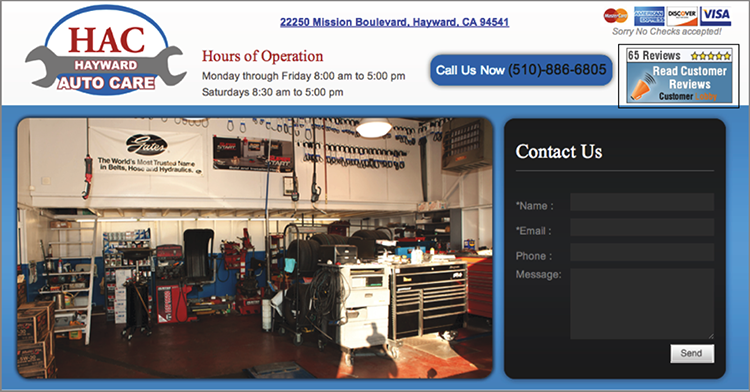
Figure 2-18: Demandforce reviews in Google results
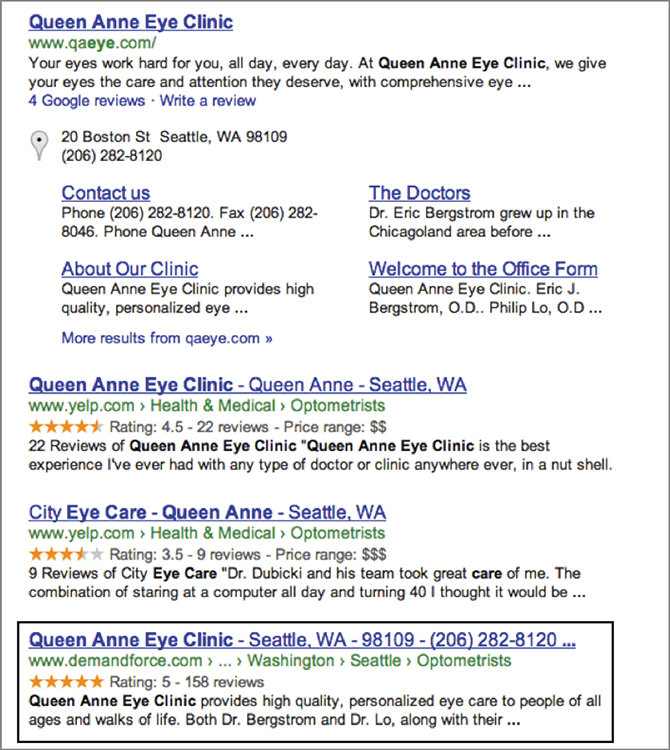
Figure 2-19: Demandforce reviews syndicated to Judy’s Book

Local Search
The local search venues described in this section are not standalone sites. They exist as the local business listings—complete with owners’ profiles, customers’ reviews, and pins on a map—within major search engines. Search engines get a chance to show off their local business listings every time a searcher’s query has a local-business focus. For example, <locksmith> and <plumber> typed into Google’s search box will bring up local results, as will <lawyer san diego> and <schools 02134>. With growing visibility of business listings and reviews in search results, local search is a major channel for both customer acquisition and online reputation. Table 2-7 shows features of local search venues.
Table 2-7: Local search venues
| Examples of local search venues | Google+ Local Yahoo! Local |
| Who is reviewed? | Brick-and-mortar businesses and businesses whose workers travel to local customers. |
| Where they stand on businesses encouraging reviews | Generally okay with encouraging reviews, although Google frowns on incentivizing reviews or in-store collection of reviews by business owners. |
| Where reviews are seen | Search engine results and mobile apps. |
| How they work with businesses | Businesses can create or claim a free listing. Google offers free reporting tools and listing enhancements such as photos, videos, and promotional offers. Yahoo! Local offers similar reporting and enhancements for a monthly fee. |
The local search reviewscape is dominated by Google, as all things involving search are. Smaller player Yahoo! Local (http://local.yahoo.com) is one feature that still remains vibrant within the Yahoo! brand.
Bing local search reviews are powered by Yelp at this writing, so Bing doesn’t belong in the local search discussion today. (Fun fact: Google tried and failed to buy Yelp before building the local service it has now.) Smart money has Bing integrating the recommendation engine Facebook Graph Search into its search results in the near future.
Reviews on Google+ Local and Yahoo! Local can be highly visible. Due to their prominence on mobile devices, they can reach prospective customers at crucial moments in the decision-making process. It’s typically a good idea to keep a close eye on these reviews.
How They Work
Like Yelp and other review sites discussed in this chapter, local search venues are fundamentally a collection of local business profiles with associated customer reviews. Local businesses can create a listing, but these sites also commonly generate listings without the business’s knowledge or approval. Businesses can claim their listing to add supplementary information—we’ll walk you through the process for Google+ Local in Chapter 6, “Review Venues: Need-to-Know Tips for Your Action Plan.”
Local search review venues deserve your special attention because of their strong integration with the search engines. Whereas review sites tend to be standalone entities, Google+ Local reviews are integrated into its large, dynamic, and heavily trafficked search engine and apps, making it easier for these reviews to gain visibility both intentionally and serendipitously. See Figure 2-20 for an example of how reviews are integrated into a Google search result.
Figure 2-20: This Google search result for the Norton Simon Museum incorporates review stars as well as links to read and write reviews.

As a result of the prominence of local listings within search results and businesses’ inevitable lust for influence over this presence, an entire industry has sprung up around local search engine optimization. Local SEO encompasses efforts (some of which you’ll learn about in this book) to improve ranks and listing quality for locally oriented searches.
Like most review sites, local search venues do not provide robust troubleshooting or mediation services for business owners looking for help with the reviews on their free listings. Their primary job is to serve their audience: the searching public, yearning for easy-to-find, comprehensive, and trustworthy local business information. And like review sites, local search venues are always happy to accept advertising dollars from business owners. We’ll visit Google+ Local advertising options in Chapter 6.
Gathering Reviews
For Google, the container for its local business reviews is its social network called Google+ (pronounced “Google plus”). Google’s local business listings have undergone such rapid evolution that, in addition to the current name (Google+ Local) you may still find people referring to them as Google Maps or Google Places. Business listings are created within Google+ and reviewers must be signed in with a Google+ account and use a real name. Far from an exclusive club, Google+ has accounts numbering in the hundreds of millions.
Google+ Local and Yahoo! Local count on strong search and social integration to encourage reviews. They recognize but don’t particularly relish the fact that businesses will solicit reviews from customers. To bulk up its review library, Google+ Local also incorporates scores and summaries from venerable local ratings company Zagat (which Google owns) and links to a large number of sources such as Urbanspoon, Foursquare, Judy’s Book, and Demandforce.
Visibility for Reviews
Google did not arrive first to the reviews game, but it has successfully insinuated itself onto the playing field. Whether the intention of the searcher is to find a business’s address and phone number or to locate a Yelp review, there’s a good chance that Google will serve up its own review elements in search results. Google+ Local content will often be ranked higher, formatted more attractively, and presented in a more invitingly clickable way than listings from any competing local review site. See Figure 2-21 for an example.
Figure 2-21: For the search query: <berlin currywurst review>, Google gives Yelp first billing but displays its own local review results in two other graphics-rich and colorful listings on the same page.
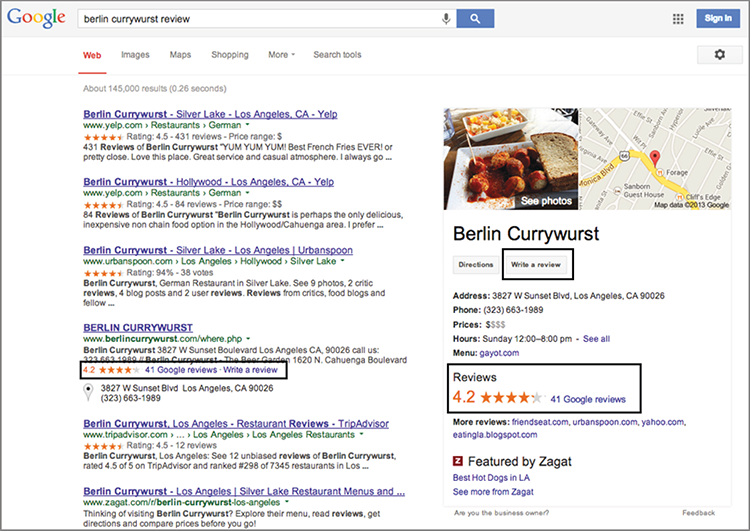
In 2011 Marissa Mayer, then Google’s Vice President of Location and Local Services, said that 20% of Google searches are looking for local information (SEOs call this local intent). This number skyrockets to 50% or more in mobile search. With local info such a key interest for searchers, Google and Yahoo! are going to keep doing what they can to get the right stuff—not the least of which is reviews—front and center in search results.
As you may have guessed by now, you will probably need to analyze and engage with more than one venue in order to effectively monitor and manage your own online reviews. We hope you’ve got a general idea of opportunities that are well matched to your business, but we won’t leave you with generalities! In Chapter 4, “Monitoring and Learning from Your Reviews,” we’ll show you how to identify specific venues that matter most for your business.
Fake Reviews
Consumers place a growing level of trust in online reviews, but is this trust deserved? With the explosive growth of online reviews and their unmistakable power to uplift or damage a business, inevitably some bad eggs are trying to cheat the system. Review sites like Yelp and Google+ Local are fighting back with every weapon they’ve got, both legal and algorithmic. As you boldly dive into your online reviews space, you may come face to face with fake reviews. And, let’s be real, you might even be tempted to cross over to the dark side and generate some fake reviews yourself. Read on, and you’ll be well versed in the who, what, and why of fake reviews.
The Scale of Fake Reviews
Bing Liu knows a little bit about fake reviews. He’s a computer science professor at University of Illinois at Chicago, and he has been studying them for decades. When we spoke with Professor Liu, he shared a surprising piece of information with us: He estimates that 30% of online reviews are fake.
Not every business or product will have this level of online shenanigans, but the alarmingly high 30% level is Liu’s estimate for an overall average, based on his research. Gartner research puts the number lower, at 10%–15%. The highest estimate of the prevalence of fake online reviews we’ve seen is 40%, as estimated by HotelMe.com, specifically in the category of hotel reviews. Any way you slice it, the number of online reviews that are not genuine is much higher than most people realize.
The most common fake online reviews are positive ones that have been written or commissioned by the business itself. Businesses have so much to gain from positive reviews that the temptation to bend the rules and add a few positive reviews for themselves is strong. Anecdotal stories of fake online reviews abound: As far back as 2009, a cosmetic surgery company was busted by the State of New York for sending emails to employees instructing them to pose as satisfied customers online. An entrepreneurial if ethics-challenged fellow named Todd Rutherford unapologetically ran a bustling business writing fake Amazon reviews at the low price of 50 for $499. And online magazine Eater.com even runs a blog called Adventures in Shilling to publicly call out fake-looking restaurant reviews. Despite the fakery, trust in online reviews is growing, and according to a 2012 survey by LateRooms.com, 45% of consumers believe the reviews they read are real.
Fake negative reviews are much rarer than fake positive ones and do not seem to be the focus of the paid services that offer to write reviews on demand. If you think you’re seeing a fake negative online review, it could be the handiwork of an individual with a vendetta or a competitor on a crusade. If your business has been victimized, either by a completely fake review posted by a competitor, or by a real but dishonest or inaccurate review posted by an actual customer, you may have some recourse. We’ll discuss some options in Chapters 6 and 7.
Love for Sale
As the free market economy would have it, opportunistic companies have sprung up to cater to some businesses’ desire for glowing reviews. Figure 2-22 shows an ad for an online review creation service that violates the terms of service for every review venue you should care about.
Figure 2-22: Advertisement for online review writing service

We don’t think anyone knows exactly who is purchasing fake reviews, but Bing Liu’s best guess is that mostly smaller businesses use these services, not large brands. Any company with a legal department probably has someone in a suit wisely putting the kibosh on this idea.
Small businesses, on the other hand, may not be sufficiently savvy to know the downside of faking online reviews. Feeling desperate and vulnerable is not the best condition under which to make a decision, and we beg you not to purchase fake reviews if this describes your mood right now.
Here are a few pros and cons of faking online reviews:
We hope the cons listed here are convincing enough to dissuade you from commissioning fake reviews for your business. If you’re dead set on purchasing fake reviews no matter what you read in this book, don’t say we didn’t warn you! We suggest that you dedicate at least a month to working on improving your genuine online reputation first. And for the sake of your business, be sure you continue to do the good work you need to also gain real ones.
On one end of the spectrum, some businesses are commissioning totally fake reviews. On the other end, some businesses are steering clear of doing anything to improve their reviews. In the space between, there is room to take some proactive steps to encourage reviews. Exactly when “proactive” crosses over the line to unethical is a subject of a great deal of discussion, which we’ll cover in Chapter 5, “How to Get More Reviews.”
The Fight against Fake Reviews
The success of review sites such as Yelp, TripAdvisor, and Urbanspoon depends on the quantity and credibility of their reviews. This means they have a strong incentive to root out and fight against fake reviews on their site—and also an incentive to downplay the scale of the fake reviews problem.
E-commerce sites, including Amazon, have much to gain and not as much to lose from the presence of fake positive reviews on their site. Positive reviews, after all, increase their bottom line by encouraging more purchases. Paradoxically, incentivized reviews (in which the reviewer receives discounts or some other form of compensation) have even been shown to be rated as more helpful by readers. This is not to say that these businesses don’t have an interest in maintaining the credibility of reviews on their sites. Big retailers like Amazon and review platforms like Bazaarvoice state in no uncertain terms that fake reviews violate their terms of service and that action will be taken if fake reviews are discovered. Unfortunately, genuine reviews are often caught in the same net.
Here are some of the main ways that review sites and services are fighting the battle against fake reviews:
Figure 2-23: This notice from Google+ goes on to set a timeline for suspension of the user’s Google+ profile if a real name is not used.




By now, you should have the knowledge you need to trace almost any review you encounter online back to its source. You might even feel like you have a pretty solid understanding of the technical underpinnings of the online review machinery. Now, get ready to learn about an even more complex machine: the reviewer.
